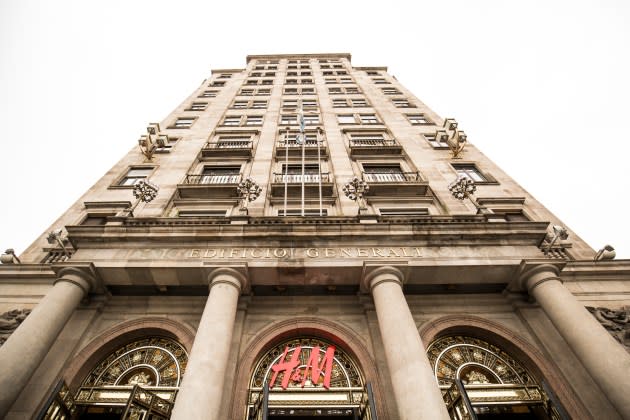H&M Launches Cost-cutting Drive After Q3 Profit Hit

H&M’s Russia exit as well as inflation and a weak performance in its key European markets caused the retailer’s profits to nosedive in the three months to Aug. 31.
Times are tough for fashion’s mass-market players as consumers tighten their purse strings in a context of rising inflation, especially in Europe.
More from WWD
H&M Group on Thursday unveiled a cost-cutting program through which it hopes to reduce its overheads, simplify its organizational structure, facilitate quick decision-making and remove layers, the retailer said during a conference call to discuss its third-quarter results. The changes are expected to take around six to nine months, and bear fruit starting in the second half of next year.
“This is expected to free up 2 billion Swedish kronor per year,” said chief executive officer Helena Helmersson during the call.
Winding down its Russian operations, increased raw materials and freight costs, the strong dollar and weak sales in many of its major markets all had a knock-on effect on H&M’s profitability in the third quarter.
In the three months to Aug. 31, the Swedish fast-fashion retailer reported operating profit of 902 million Swedish kronor, or $79.6 million at current exchange, compared with 6.27 billion Swedish kronor, or $553 million, in the prior-year period.
Net profit came in at 531 million Swedish kronor, or $46.8 million, versus 4.69 billion, or $413.7 million, a year ago.
Shutting down operations in Russia accounted for around half of the profit decrease, Helmersson said. “Increased raw materials and freight prices as well as a stronger U.S. dollar resulted in substantial cost increases for purchases of goods,” she commented.
While business in the Americas and Asia (outside China) were good, the company’s activities in Europe — which accounted for more than 60 percent of its sales in the third quarter — were down significantly, which H&M attributed to the summer heatwave as well as increased consumer price sensitivity.
Business picked up progressively through the quarter after a rough start, said the retailer, which operates Arket, Cos, Monki, &Other Stores and Weekday in addition to its core H&M stores.
It noted that since the end of August, its fall collections have been well-received, and that sales in the Sept. 1 to 27 period were up 7 percent year-over-year in local currencies. This offers “important proof that the H&M group is growing even when customers’ purchasing power is decreasing,” Helmersson asserted.
In the recent past H&M has consistently underperformed its biggest rival, Spain’s Inditex, which said on Sept. 14 that its sales grew 11 percent year-over-year in constant-currency terms between Aug. 1 and Sept. 11. Its first-half sales were up 25 percent at constant currencies.
While Inditex has implemented a mid single-digit increase in prices to counter inflationary headwinds, as reported, H&M decided not to pass cost hikes onto its consumers across the board, which has negatively impacted margins. “We have increased prices, but not to fully compensate for the severe headwinds in sourcing,” said Nils Vinge, head of investor relations, during the call.
H&M’s operating margin for the third quarter, not including the one-off cost of closing its Russian operations, was 5.2 percent, compared with 11.3 percent in the prior-year quarter.
“We have adjusted prices differently in different markets and different segments,” Helmersson explained. “It’s very important now to stay flexible within certain areas and pricing is one of them…Some segments are less price sensitive than others, so we try to work with these in a very flexible way.”
While H&M expects pricing pressures on raw materials and freight to ease in the back part of the year, said Vinge, the rising value of the U.S. dollar is expected to have a knock-on effect in the coming months.
“Input costs have peaked, and we believe that they are on an elevated but stable level; what has not peaked and is on a negative trajectory is the currency effect. That’s the big headwind now,” he said.
“The world around us is very challenging at the moment,” Vinge continued. “Visibility is very, very low; that’s why flexibility, speed, efficiency is more important than ever.”
H&M’s management hopes to benefit by better highlighting the retailer’s value proposition going forward. “We have good chances in this environment to succeed and improve our positioning,” said Vinge.
“When we…put even more effort into showing our great prices, something we think we could have done even more during the third quarter…we also see better progress,” said Helmersson. “When customers have less money to spend, it’s super important both in physical stores and online to really highlight the great prices, great value for money that we have.”
H&M’s net sales for the third quarter totaled 57.45 billion Swedish kronor, or $5.97 billion at current exchange. This represented a year-over-year increase of 3 percent in reported terms, but a 4 percent decline in local currencies.
For the nine-month period, H&M’s net profit dropped 30.7 percent to 4.43 billion Swedish kronor, or $390.7 million, despite a 13.3 percent increase in reported sales, to 161.12 billion Swedish kronor, or $14.21 billion.